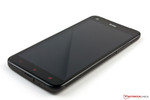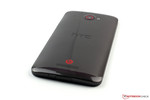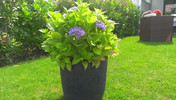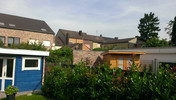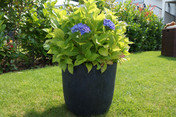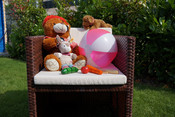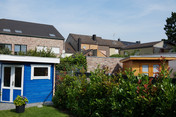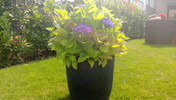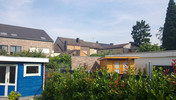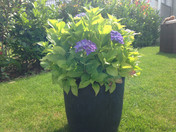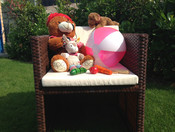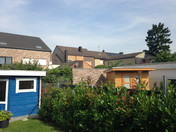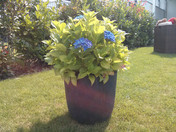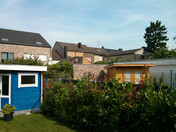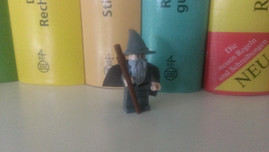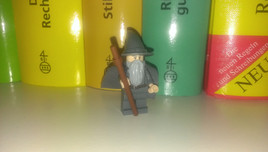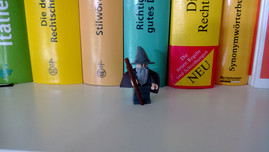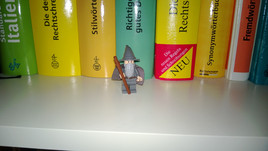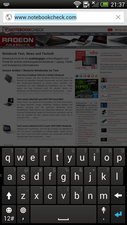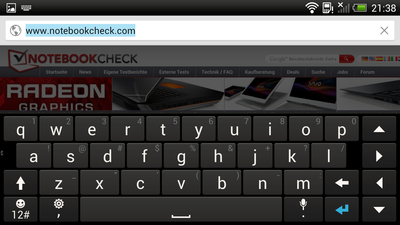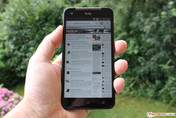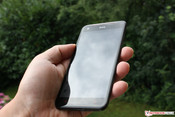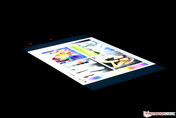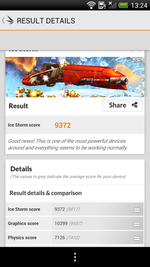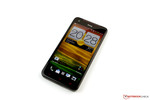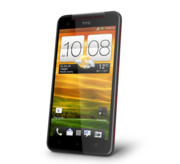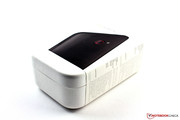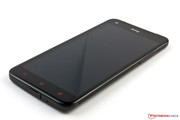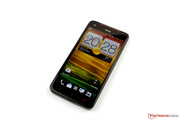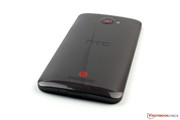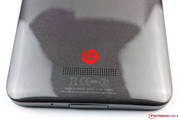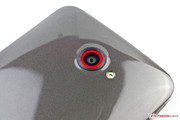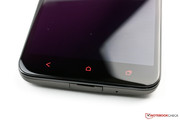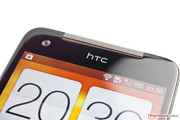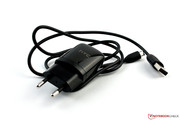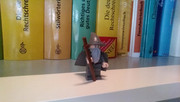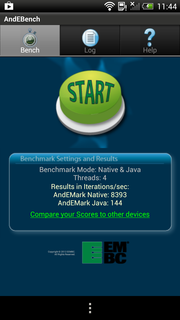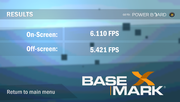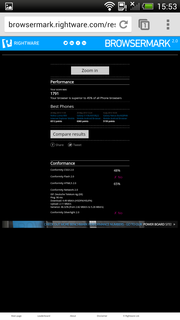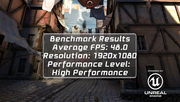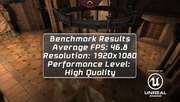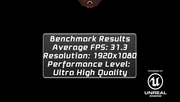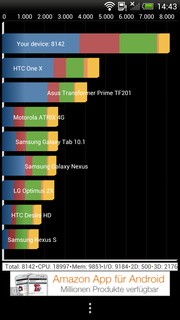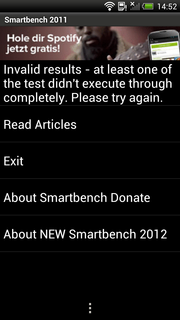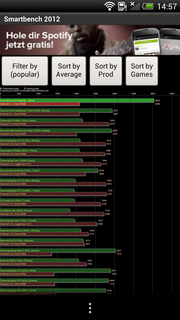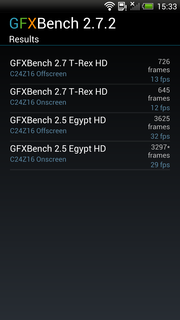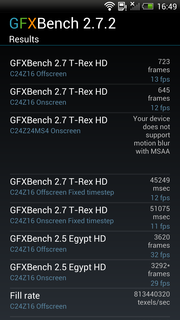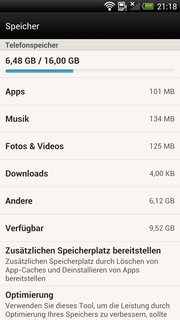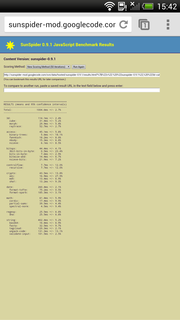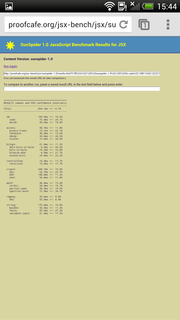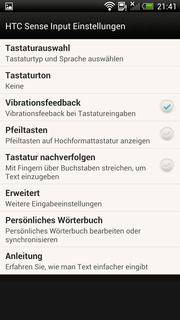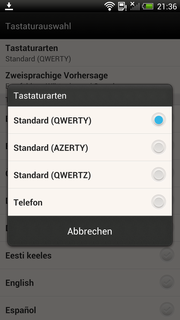Review HTC Droid DNA (Butterfly) Smartphone

For the original German review, see here.
The HTC Droid DNA has a 5.0-inch display with a resolution of 1920x1080 pixels. A Qualcomm quad-core processor should provide sufficient performance for the Android smartphone and 2 GB memory and 16 GB internal storage are pretty much standard in this device class. The back of the case is made of plastic and the Droid DNA fills HTC's gap between inexpensive mainstream smartphones and high-end devices.
Similar devices are also offered by the competition; Sony Xperia ZL and LG Optimus G E975 aim for the same customers. In regard to the display, the new Droid DNA also competes with current high-end devices: HTC One, Samsung Galaxy S4, and Sony Xperia Z are also equipped with Full HD screens. However, we should not forget the comparison with inexpensive import products from China; high-resolution displays are also available in the lower price segment like in the iOcean X7, for example.
Case
The dimensions of the smartphone are 143.0 x 70.5 x 9.08 millimeters (~5.6 x 2.8 x 0.4 inches) and it weighs 137 grams (~4.8 ounces). The front looks as if it was made of one piece but a closer look reveals the thin black plastic frame that surrounds the 5.0-inch display; Corning Gorilla Glass 2 is used to protect the display against scratches and impacts. The back is made of anthracite plastic, which is very catchy despite the smooth surface. All edges are rounded, which does not only look good but improves the handling as well.
The case is very torsion resistant and there are no creaking noises at all. Concentrated pressure on the back of the device is not visible on the screen and the Droid DNA is also IPX5 certified. That means it resists water jets (for example from a hose or a water faucet) from any angle. This should however not be confused with the IP57 certification of the Sony Xperia Z, which is even protected against a complete submersion.
A bit awkward is the cover for the USB port; you have to be patient to plug it in seamlessly. All in all the HTC Droid DNA leaves a good impression in regard to the build quality.
Connectivity
HTC equips the Droid DNA with 16 GB flash storage; 9.52 GB are available for the user after the initial set-up. That is not very generous considering that the smartphone can display Full HD movies in the native resolution. This is also the reason that we really miss a memory card slot, although it was initially advertised with one. We cannot really understand why the inexpensive expandability option was waived from the features list.
The remaining equipment is meager. You get a micro USB port (2.0 standard) that can be used for data exchange and recharging. A Mobile High-Definition Link (MHL) is also integrated into the USB port; you can stream video and audio signals (1080p, 7.1 surround sound) to an external display (e.g. TV or projector) with an HDMI port via optional MHL adaptor. Finally, there is the mandatory 3.5 mm stereo jack.
Software
The operating system is Android 4.1.1 and HTC integrates the customized user interface Sense 4+. We would have expected the latest version of Google's operating system and Sense 5 for a new smartphone. The update to Android 4.2.2 and Sense 5 is already available in Taiwan but it is still uncertain when the update package will be available for the rest of the world.
The internal storage also accommodates the PC-Synchronization software in five different versions (Windows XP, Vista (32- and 64-bit) as well as Windows 7 (32- and 64-bit)) besides the PDF user guide. This comfortable accessibility of the software only needs 15 MB of storage; we only missed a version for Mac OS.
We made a short Look and Feel video to give you a better impression of the user interface and the performance.
Communication & GPS
The mandatory WLAN module can also be found inside the HTC Droid DNA. It supports the WLAN standards IEEE-802.11 a/b/g/n in 2.4 and 5.0 GHz networks. The reception is good, even outdoors and at a distance of around 20 meters (~66 feet) from the router, we had no problems while browsing the web. Bluetooth 4.0 is also integrated and supports the aptX standard, which enables the transmitting of stereo audio signals to a compatible output device. NFC is also available.
Our European review unit is not well equipped in terms of mobile data connections. You can only use HSPA with support for the 850 and 2,100 MHz frequencies. An LTE module is not integrated, but this varies depending on the region.
A-GPS and a Glonass receiver can be used to locate your position. The accuracy is good even indoors. It takes about 1 minute before the Droid DNA connects with the satellites but it is faster outdoors. As a result there is no criticism with the GPS reception.
Telephone Functions and Voice Quality
It does not really matter if you previously used a Windows Phone or an iPhone; the telephone functions are very easy to use. HTC did not modify the basic structure of the Phone App with its Sense user interface, only the Favorites-button has been removed and the controls have been resorted.
The voice quality is on a good level. The caller is usually easy to understand and there were no problems on the other side of the line, either. Fortunately, the hands-free feature worked very well. We were easy to understand; only the caller sounded a bit tinny and the voice was a little distorted sometimes.
The provided headset works well for calls but is not well suited for music playback. The sound experience with Beats Audio is much better with higher quality headphones.
Cameras & Multimedia
Contrary to the HTC One, the Droid DNA does not have an UltraPixel camera. It has an 8 megapixels sensor (3264x1840 pixels) with an auto focus, an LED flash and an image stabilizer. The latter should provide acceptable results especially under bad lighting conditions. The front camera has 2.1 megapixels, which is quite a lot, and enables Full HD (1920x1080 pixels) video calls. It also has an 88° ultra wide-angle lens.
Our tests reveal that the main camera of the HTC Droid DNA cannot keep up with the competition. Close ups and scenes shot in daylight are overexposed and the colors are too bright. The situation is better with panoramas, the colors are more consistent and harmonious and the Droid DNA can even surpass the Nexus 4 in this scenario. In terms of sharpness, it is far behind competitors like the iPhone 5 or Lumia 920, but our review unit is sufficient for snapshots with good lighting conditions.
Bad lighting conditions result in picture noise. Even in the twilight you will need the flash to get a decent picture, otherwise the sample pictures are coated with a gray film. The picture is sharp when you use the flash but the colors are very unnatural. The Lumia 925, which has the same aperture (f/2.0), shows better results. The pictures are sharp and the colors are natural even without the flash.
The webcam produces decent results. You should have no problems during video calls and good lighting conditions. Once again, dark environments result in strong picture noise.
Accessories
Besides the modular power supply unit with a maximum power output of 5 Watts, HTC provides a small tool to open the SIM tray as well as an In-Ear headset. The Taiwanese manufacturer also offers several accessories, which can be used universally for all smartphones. Among others, you can buy Bluetooth headsets, external batteries and a DLNA receiver for HTC Media Link HD.
Warranty
HTC grants a 24-month warranty for its smartphone. It is a simple Bring-In service that covers possible manufacturing defects. The warranty cannot be extended.
Input Devices & Handling
The three usual sensor buttons beneath the display are the only physical control elements for the Android operating system and work very well. The capacitive 5.0-inch touch screen reacts quickly and precisely to inputs; scrolling is very smooth and rotating the device does not result in delays. The display can handle ten inputs simultaneously but the manufacturer preselected that only three inputs are recognized simultaneously for applications in the display settings. In this case, the display can only recognize two touch inputs at the same time.
The virtual keyboard works well and its size in the portrait mode is sufficient thanks to the large display. The additional space is used for arrow keys in the landscape mode. It is a bit annoying that the QWERTY-layout is displayed although we selected the German keyboard. This setting can be changed via HTC Sense Input settings.
Display
We expect a lot from the display since it was already one of the highlights of the HTC One. Both smartphones use the same Super LCD 3 panel but the Droid DNA is another 0.3 inches larger than the 4.7-inch touchscreen of the One.
The display of the Droid DNA has a resolution of 1920x1080 pixels, which matches an aspect ratio of 16:9. The pixel density is very good with 441 ppi, identical with the Samsung Galaxy S4 (441 ppi) and it can clearly surpass the iPhone 5 (326 ppi). The colors of the SLCD are vibrant and very sharp; there is absolutely no criticism in this regard. The average display brightness of the Droid DNA is also very good with 380 cd/m². HTC's flagship is on another level with 488 cd/m² and the iPhone 5 is clearly brighter (487 cd/m²). Sony's displays in the Xperia ZL (577 cd/m²) and Xperia Z (427 cd/m²) are also very bright. The brightness distribution of our review unit is decent with 89% and the differences are not visible to the human eye. The Droid DNA has no problems with screen bleeding.
| |||||||||||||||||||||||||
Brightness Distribution: 89 %
Center on Battery: 371 cd/m²
Contrast: 1159:1 (Black: 0.32 cd/m²)
ΔE Color 4.34 | 0.5-29.43 Ø5
ΔE Greyscale 2.31 | 0.57-98 Ø5.3
Gamma: 2.39
Similar to the brightness it is also evident with the contrast ratio (1,159:1) and black value (0.32 cd/m²) that the HTC One is equipped with a higher quality display (2,117:1, 0.23 cd/m²). Both devices cannot keep up with the Galaxy S4 (2,487:1, 0.12 cd/m²) in this regard. The Super AMOLED has a theoretical black value of 0 cd/m². Nevertheless, the results of the Droid DNA are very good.
Ex-works we measured the color accuracy and the color presentation of the display with the CalMAN 5. There are no visible deviations in the color accuracy; no color surpasses a DeltaE value of three. The result for the saturation is not as good; blue has the biggest deviation but is still in the tolerable area (DeltaE below 10). Grayscale presentation (DeltaE 2.3) and Color Checker (DeltaE 4.3) are also very good. Subjectively the picture is brilliant and there are no color distortions like with the IPS display of the iOcean X7.
Due to the combination of high contrast ratio and good display brightness, the HTC Droid DNA is well suited for outdoor use. The content is hard to see under direct sunlight but that is mainly caused by the glossy display surface, a problem of almost all smartphones. Without direct sunlight, there are absolutely no problems with the readability.
The viewing angle stability of the Super Liquid Crystal Display is excellent and can easily compete with good IPS panel and OLED screens. We could not determine any color distortions or brightness reductions even with extreme viewing angles.
Performance
HTC uses the fast Qualcomm Snapdragon S4 Pro quad-core processor with a maximum clock of 1.5 GHz. Graphics are handled by the Adreno 320 GPU, the configuration is supported by 2 GB RAM and 16 GB flash storage.
This combination should result in sufficient performance. However, the multi-platform benchmark 3D Mark Ice Storm result of the HTC Droid DNA is surprisingly low compared to the rivals from Sony or LG with similar hardware. Our review unit only gets 7,388 points, both the Xperia ZL (8,971 points) and the E957 (10,223 points) are clearly ahead. However, this phenomenon only affects very GPU demanding benchmarks. A possible reason could be high GPU temperatures; another benchmark run with the active cooling of the HTC Droid DNA confirms our assumption. Now the 3D Mark Ice Storm result was 9,372 points. Since the device gets warm but not truly hot, the GPU core clock is reduced (throttling). Neither CPU demanding applications nor the system performance are affected by this; subjectively everything is smooth and very quick.
| 3DMark | |
| 1280x720 Ice Storm Standard Score (sort by value) | |
| HTC Butterfly | |
| Sony Xperia ZL | |
| LG Optimus G E975 | |
| Apple iPhone 5 | |
| HTC One | |
| Samsung Galaxy S4 GT-I9505 | |
| 1280x720 Ice Storm Standard Graphics (sort by value) | |
| HTC Butterfly | |
| Sony Xperia ZL | |
| LG Optimus G E975 | |
| HTC One | |
| Samsung Galaxy S4 GT-I9505 | |
| GLBenchmark 2.5 - 1920x1080 Egypt HD Offscreen Fixed Time (sort by value) | |
| HTC Butterfly | |
| iOcean X7 | |
| Sony Xperia ZL | |
| LG Optimus G E975 | |
| Apple iPhone 5 | |
| HTC One | |
| Samsung Galaxy S4 GT-I9505 | |
| GFXBench (DX / GLBenchmark) 2.7 - 1920x1080 T-Rex Offscreen (sort by value) | |
| HTC Butterfly | |
| iOcean X7 | |
| Sony Xperia ZL | |
| LG Optimus G E975 | |
| Apple iPhone 5 | |
| Sony Xperia Z | |
| Samsung Galaxy S4 GT-I9505 | |
| Smartbench 2012 - Gaming Index (sort by value) | |
| HTC Butterfly | |
| iOcean X7 | |
| Sony Xperia ZL | |
| LG Optimus G E975 | |
| Sony Xperia Z | |
| HTC One | |
| Samsung Galaxy S4 GT-I9505 | |
Google Chrome is the standard web browser and we used it (version 28) for our benchmarks. Subjectively web pages load very quickly with almost no delays. The benchmarks confirm the positive impression; the Droid DNA can even beat the leading Android device Samsung Galaxy S4 in Sunspider 0.9.1. However, this comparison is dominated by Windows Phones.
Browsermark 2.0 is dominated by the S4 and the iPhone 5 with a very big lead. Compared to similarly equipped smartphones, the Droid DNA gets a noticeably better result. The reason for this might be the newer browser version.
| Sunspider - 0.9.1 Total Score (sort by value) | |
| HTC Butterfly | |
| Sony Xperia ZL | |
| LG Optimus G E975 | |
| Samsung Galaxy S4 GT-I9505 | |
| iOcean X7 | |
| Apple iPhone 5 | |
| Nokia Lumia 920 | |
| HTC Windows Phone 8X | |
| Browsermark - --- (sort by value) | |
| HTC Butterfly | |
| Sony Xperia ZL | |
| LG Optimus G E975 | |
| Samsung Galaxy S4 GT-I9505 | |
| iOcean X7 | |
| Apple iPhone 5 | |
| Nokia Lumia 920 | |
* ... smaller is better
16 GB of flash storage is integrated into the HTC Droid DNA. This is not uncommon, but considering the data intensive ways of using a smartphone it is not sufficient. The Xperia ZL has a micro SD slot besides the 16 GB internal storage and the LG E975 even comes with 32 GB storage ex-works.
Unfortunately, neither the capacity nor the performance of the storage can keep up with the competition. The rivals are 22% faster in the read performance (4k). All in all, it is certainly not a bad solution but compared to other devices in this price range it is just too slow.
| AndroBench 3-5 | |
| Random Write 4KB (sort by value) | |
| HTC Butterfly | |
| Sony Xperia ZL | |
| LG Optimus G E975 | |
| HTC One | |
| Google Nexus 4 | |
| Random Read 4KB (sort by value) | |
| HTC Butterfly | |
| Sony Xperia ZL | |
| LG Optimus G E975 | |
| HTC One | |
| Google Nexus 4 | |
| Sequential Write 256KB (sort by value) | |
| HTC Butterfly | |
| Sony Xperia ZL | |
| LG Optimus G E975 | |
| HTC One | |
| Google Nexus 4 | |
| Sequential Read 256KB (sort by value) | |
| HTC Butterfly | |
| Sony Xperia ZL | |
| LG Optimus G E975 | |
| HTC One | |
| Google Nexus 4 | |
Gaming
The Adreno 320 GPU provides sufficient performance for mobile gaming, despite the throttling issue under load. Even the latest 3D games like Real Racing 3 or Iron Man 3 run very smooth. Less demanding titles like Angry Birds or Fruit Ninja are therefore no challenge for the smartphone.
The excellent display improves the gaming experience, just like the good response of the position and gyro sensor.
Emissions
Temperature
The HTC Droid DNA is very cool during idle and only gets lukewarm at the bottom display frame but it never surpasses the 35 °C/95 °F barrier. The Sony Xperia ZL (up to 39.3 °C/102.74 °F) is much hotter in this scenario. Only the LG E975 is a noticeably cool smartphone with a maximum temperature of just 31.3 °C/88.34 °F.
We use the application Stability Test (GPU and CPU load) for at least one hour to simulate the maximum load and measure the temperatures. The Droid DNA is just slightly warmer compared to the idle operation (42.6 °C/108.68 °F). This is not critical but it can become unpleasant in your hands during gaming. The results for the competition are similar (Sony maximum temperature of 44.4 °C/111.92 °F, LG maximum temperature of 41.9 °C/107.42 °F).
(±) The maximum temperature on the upper side is 42.6 °C / 109 F, compared to the average of 35 °C / 95 F, ranging from 21.9 to 56 °C for the class Smartphone.
(±) The bottom heats up to a maximum of 40.2 °C / 104 F, compared to the average of 33.8 °C / 93 F
(±) In idle usage, the average temperature for the upper side is 32 °C / 90 F, compared to the device average of 32.7 °C / 91 F.
Speakers
The integrated speaker is located at the back and can especially convince us with the high tones. The sound does not get distorted with high volume settings. However, the speaker is not comfortable with bass as it is basically nonexistent. All in all the sound experience is still good.
External output devices like headphones, AV receivers or TV's can use the equalizer settings of Beats Audio in the system settings. External devices can be attached via the 3.5 mm stereo jack, Bluetooth or the MHL capable micro USB port.
Energy Management
Power Consumption
We measure an idle consumption of 0.54 up to 1.5 Watts for the Droid DNA. This is not as frugal as the Apple iPhone 5 (0.4 – 1.4 Watts), but still a very good result. Our review unit consumes less energy than the Xperia ZL, which has a 260% higher consumption with 1.9 up to 3.9 Watts.
Under load, the consumption increases to 5.6 Watts, only the Nexus 4 (6.1 Watts) needs even more power. Sony's Xperia ZL is a bit more frugal with 5.1 Watts. The LG Optimus G is exemplary with just 3.7 Watts and even the Chinese smartphone iOcean X7 (4.9 Watts) consumes less energy.
| Off / Standby | |
| Idle | |
| Load |
|
Battery Runtime
The non-removable lithium-polymer battery of the HTC Droid DNA is comparatively small with a capacity of 2,020 mAh. The batteries of the Sony Xperia ZL (2,370 mAh) and LG Optimus G E975 (2,100 mAh) are slightly bigger. Due to the high load consumption that we simulated with the application Stability Test (GPU + CPU load) and the smallest battery in the comparison, the HTC Droid DNA only manages a minimum runtime of two hours and 40 minutes, the worst result within the competition. As expected, the devices from Sony (03:15 hours) and LG (03:32 hours) last longer.
The maximum runtime of the Droid DNA is also comparatively low with almost 11 hours. The rivals can clearly surpass the HTC in this scenario; the Xperia ZL manages a little more than 14 hours and the frugal LG E975 even manages more than 18 hours.
Our WLAN Test is the most realistic scenario. With an adjusted display brightness (150 cd/m²), the review unit loads a new website every 40 seconds via a script. The Droid DNA manages a runtime of seven hours and 13 minutes; an average result at best, which is not even close to the 11 hours of the Optimus G.
Verdict
The HTC Droid DNA inspires with a vibrant display and high build quality of the stylish case. It is evident that the Taiwanese manufacturer did not integrate the same high-quality components from the HTC One and only uses a Snapdragon S4 Pro for the Droid DNA, which still offers enough performance for all applications. Even the throttling of the GPU Adreno 320 under continuous load is tolerable because the performance is still sufficient.
Drawbacks of our review unit are the limited storage, which is not expandable, the short battery runtimes and the comparatively high price. You can get the bigger sibling HTC One for just 70 Euros (~$93) more; it not only has a brighter display and a more powerful CPU but also twice as much storage capacity. Finally, all versions of the HTC One have LTE modules.
If the retail price drops over the next weeks, the Droid DNA will certainly become a more attractive alternative. The price pressure for mainstream devices is very high; Sony (starting at 449 Euros/~$599) and especially LG (starting at 306 Euros/~$408) are considerably less expensive. However, if you want to use your smartphone for daily tasks and some occasional gaming you will be satisfied with the HTC Droid DNA.


 Deutsch
Deutsch English
English Español
Español Français
Français Italiano
Italiano Nederlands
Nederlands Polski
Polski Português
Português Русский
Русский Türkçe
Türkçe Svenska
Svenska Chinese
Chinese Magyar
Magyar